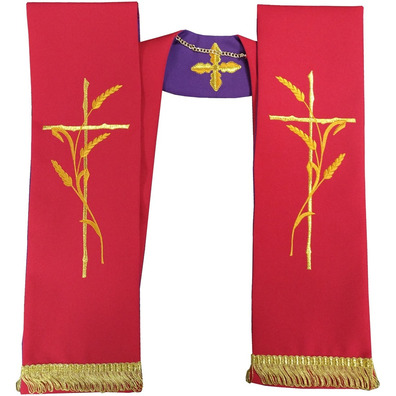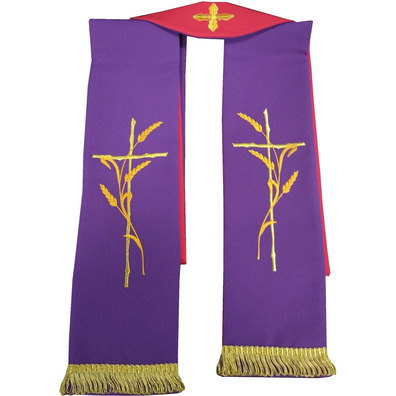Priest reversible stole | Catholic Church vestments red/purple
Reversible Stoles for Catholic Priests
- Reversible stole with religious embroidery in gold thread.
- Available in two combinations: white-green and red-purple.
- 12.5 cm wide.
- 260 cm. total length.
- Embroidered with a Cross and wheat spikes.
- Made of polyester.
Use of the Stole in the Catholic Church
The stole is a fabric band used in the Catholic liturgy. Priests, deacons, and bishops wear it hanging from the neck over the chest, adjusted with a cincture.
It symbolizes great relevance within the liturgical vestments. The stole represents the authority and ministry of the priest in the Church, but it is also a reminder of submission to Christ and His word, a sign of humility and service to others.
Bishops and priests wear it under the chasuble, a liturgical garment that covers them during the celebration of the Eucharist.
On the other hand, deacons place it over the left shoulder and adjust it with a cincture over the tunic and under the dalmatic.
The length of the stole is carefully measured so that the ends fall elegantly when held by the cincture. The length not only highlights this liturgical garment's aesthetic and symbolic sense but also shows the attention and care put into the details within the Catholic liturgy.
Furthermore, it is essential to mention that the color of the stole should match that of the chasuble or the dalmatic, according to the liturgical calendar. Each color has its meaning and is used in specific liturgical moments. For example, the color white is used in the Lord's feasts, such as Christmas and Easter, while purple is used during the season of Lent. These color choices have a symbolic purpose and help to create an appropriate atmosphere for each celebration in the Catholic Church.








